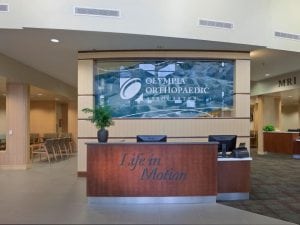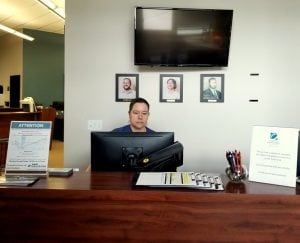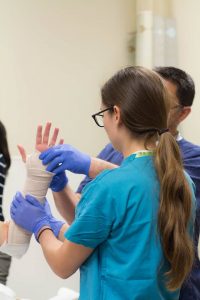If you injure one of your joints, have no fear. Help is close at hand at Olympia Orthopaedics Associates Rapid Orthopaedic Care (ROC), an urgent care orthopedic clinic with more than 20 physicians who can take care of everything from sprained ankles to torn rotator cuffs. The physicians assistants (PAs) each have more than a decade of experience and are used to working with a multitude of issues.
ROC’s staff can assess patients and provide initial treatment, then refer them to the cadre of doctors at OOA’s multiple locations. Hand surgeons and other sub-specialists can handle more complex cases, but every OAA physician is trained in general orthopedics, including the most common injuries that require treatment.

These include:
#1. Knee injuries. “We use our knees to move around and get up and down, plus they’re weight-bearing joints, so this is one of the top issues we see,” says Brisco. Tears of the meniscus, the cartilage that functions as a shock absorber between the thigh and shin bones, are common. In younger patients, these tend to result from sports injuries, but among older patients, even a simple movement can cause problems. “The meniscus dries out as we get older, so it’s more prone to tearing,” adds Brisco.
Soft tissue injuries like meniscus tears and ligament strains can be treated with a range of options, including physical therapy. In cases where arthritis is present, the staff takes a conservative approach. “There can be medication management, weight loss, physical therapy and occasionally injection management,” Brisco explains. “Failing all of those options, sometimes people have to think about knee replacement surgery.”
#2. Hands and Wrist Issues. Hands, as one of OAA’s surgeons likes to point out, are how we interact with the world and we beat them up all the time. “It’s a gamut,” says Briscoe. “We see wrist fractures, finger fractures, people with cuts and a lot of work-related hand injuries. Hands are about half of what we see in an urgent care or emergency room setting.”

Ligament injuries, carpal tunnel syndrome, and even cases of gout make their way through the ROC’s doors, where patients are often referred to a hand specialist to figure out the next step. “We have two hand surgeons and one PA-C who works with them,” says Briscoe, “which has helped to increase patient access over the last year.”
#3. Foot and Ankle Problems. People may expect that a broken foot or ankle would be more painful than a sprain, but in fact the opposite is often true, says Brisco. “We see it all the time,” she says. “We’ve seen people come in with broken bones that can walk on their foot and people who have sprains who can’t bear any weight at all.”
More chronic conditions like foot or ankle arthritis are less common, as are toe dislocations. OAA has two foot and ankle specialists who can deal with more complicated issues. “A lot of our team can deal with a sprained foot or ankle without a problem,” says Brisco.

#4. Shoulder Issues. Shoulder pain is one of the primary reasons people go to the doctor, Brisco notes, because it can interfere with sleep, work, and life in general. “The primary shoulder complaint we get is rotator cuff tendon pathology,” she says. “Many people are not aware that the shoulder goes through a wear and tear process just like the hips and knees do. We see everything from huge tears to what we call impingement, where the joint is swollen and irritated.”
Treatment ranges from physical therapy to medication, to cortisone shots in the shoulder, to surgery. Severe tears or advanced arthritis may be inoperable, but patients still have options. “For some, it means shoulder replacement surgery,” says Briscoe. “We have several surgeons who do those, and the surgery has advanced so far in recent decades.”
#5. Back Problems. Back problems are on the rise, particularly among young people. A sedentary lifestyle combined with large amounts of time glued to screens are contributing factors. “We’ve adopted habits of sitting in front of computers and reading on our phones where our necks are flexed all the time,” says Brisco. “We weren’t meant to be sitting all the time. All those muscles that stabilize our backs have gotten deconditioned and weak, which leads to pain.”
Losing weight and quitting smoking can kick-start the healing process by releasing pressure on the spine and eliminating nicotine, which constricts blood vessels and prevents blood flow to damaged areas. “It’s a tough addiction, but most surgeons worth their salt, including ours, won’t do surgery on your neck or back if you don’t stop smoking,” says Brisco.
The staff is very supportive of each other, she notes. “When we question anything, we know we can go to each other and ask. We also have more than 20 physicians who are always open to helping us.” To learn more about the services provided by Olympia Orthopaedic Associates, visit the Olympia Orthopaedics Associates website or call 360-709-6230.
Sponsored











































